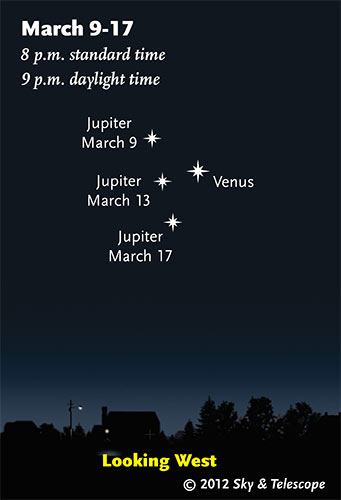Every evening for the past month Venus has appeared a little higher in the western sky and Jupiter has appeared quite a bit lower. Now they're about to cross paths. From March 9th to 17th the two planets will be within 5° of each other, fitting in a single field of view through most binoculars. They're 3° apart — a few finger-widths — at their closest approach on March 13th, and only marginally farther on the preceding and following evenings.

Tony Flanders
This will be a stunning pairing, since Venus and Jupiter are the second and third brightest objects in the night sky, after the Moon. Solidly supported binoculars will also show Jupiter's four Galilean moons as long as they're not too close to the planet, and will reveal Jupiter's tiny disk. You may also be able to make out Venus's disk, which appears slightly more than half as wide as Jupiter's. And if you look carefully, you might see that Venus is now in its gibbous phase, only 60% lit.
Jupiter will slowly disappear from the evening sky after this conjunction, becoming difficult to observe by mid-April. But Venus is still getting better; it will reach its highest and brightest in April. That's also when it will start to be a spectacular crescent through a telescope.
Jupiter and Venus will be paired again in late June and early July, but not as closely. Moreover, the planets will be very inconvenient to observe, low in twilight before dawn on some of the longest days of the year.
They will be spectacularly close after sunsets in late May 2013, with Mercury nearby to add to the excitement. Unfortunately, the trio will be very low in bright twilight.
Venus and Jupiter won't appear together again in a fully dark sky until June 2015. But that will be a truly amazing conjunction, with both planets fitting together in a high-power telescopic field of view.
 5
5
Comments
Dave Swigert
March 9, 2012 at 6:53 pm
"Every evening for the past month Venus has appeared a little higher in the western sky and Jupiter has appeared quite a bit lower."
Shouldn't this be reversed?. Jupiter is higher than venus at first!
Dave
You must be logged in to post a comment.
Warren Odom
March 9, 2012 at 10:02 pm
Dave, yes Jupiter started out much higher than Venus -- and as they approach each other, Jupiter is indeed getting lower while Venus is getting higher. No contradiction there.
You must be logged in to post a comment.
Grace Anderson
March 13, 2012 at 1:28 pm
What time of night is Jupiter and Venus at their best?
You must be logged in to post a comment.
Grace Anderson
March 13, 2012 at 1:30 pm
Oh sorry! Just saw the time 🙂
You must be logged in to post a comment.
tom hoffelder
March 13, 2012 at 3:55 pm
I was slightly confused by the diagram, probably because I expected Venus to be the one "moving" since its motion against sky is about 4 times greater than Jupe's. Maybe that is what confused Dave. But as Albert said, all is relative!
You must be logged in to post a comment.
You must be logged in to post a comment.